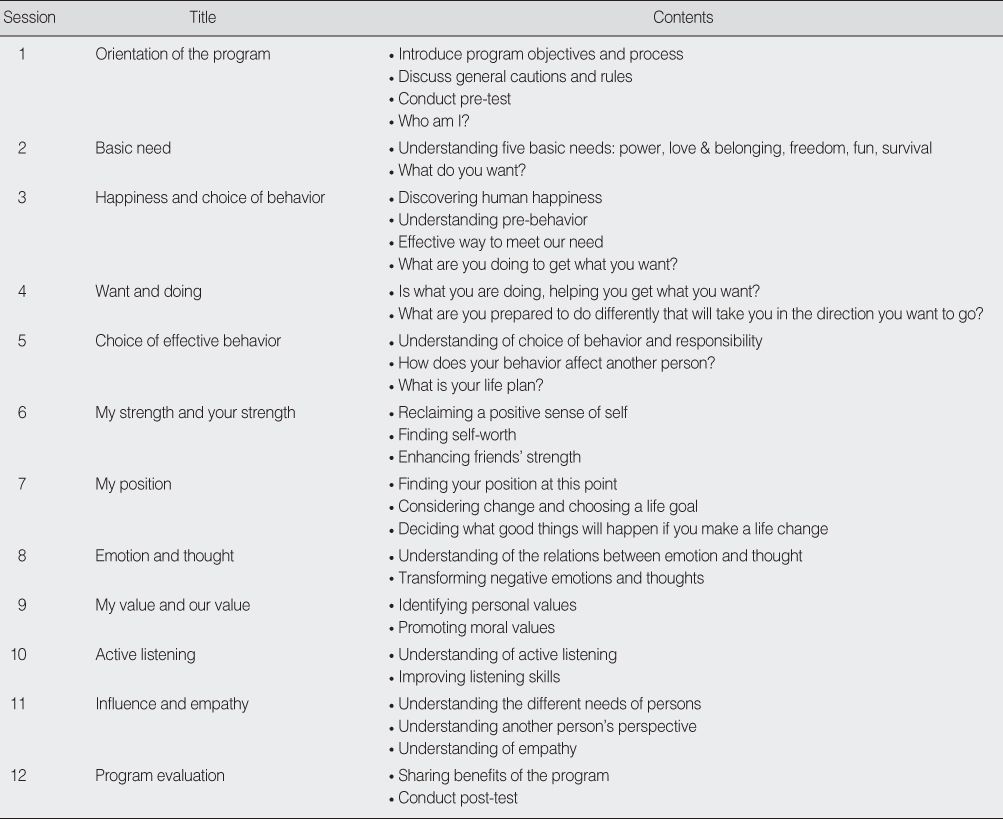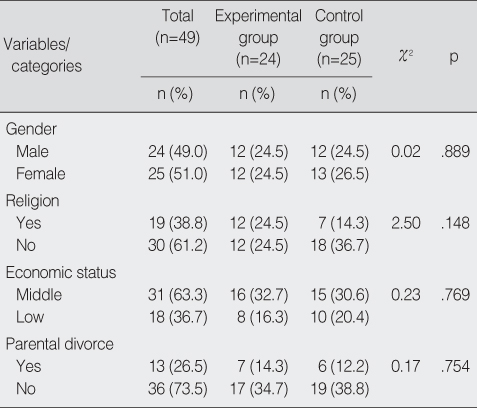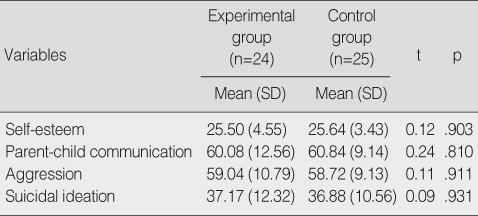Articles
- Page Path
- HOME > J Korean Acad Nurs > Volume 38(4); 2008 > Article
-
Original Article
- The Development of an Integrated Suicide·Violence Prevention Program for Adolescents
- Hyun Sook Park
-
Journal of Korean Academy of Nursing 2008;38(4):513-521.
DOI: https://doi.org/10.4040/jkan.2008.38.4.513
Published online: August 31, 2008
Department of Nursing, Catholic University of Daegu, Daegu, Korea.
- Address reprint requests to: Park, Hyun Sook. Department of Nursing, Catholic University of Daegu, 3056-6 Daemyeong 4-dong, Nam-gu, Daegu 705-718, Korea. Tel: 82-53-650-4827, Fax: 82-53-621-4106, parkhs@cu.ac.kr
• Received: May 2, 2008 • Accepted: July 4, 2008
Copyright © 2008 Korean Society of Nursing Science
Abstract
-
Purpose
- The purpose of this study was to develop an integrated suicide·violence prevention program for adolescents. Another purpose was to evaluate the effects of the integrated suicide·violence prevention program on self-esteem, parent-child communication, aggression, and suicidal ideation in adolescents.
-
Methods
- The study employed a quasi -experimental design. Participants for the study were high school students, 24 in the experimental group and 25 in the control group. Data was analyzed by using the SPSS/WIN. 11.5 program with χ2 test, t-test, and 2-way ANOVA.
-
Results
- Participants in the integrated suicide·violence prevention program reported increased self-esteem scores, which was significantly different from those in the control group. Participants in the integrated suicide·violence prevention program reported decreased aggression and suicidal ideation scores, which was significantly different from those in the control group.
-
Conclusion
- The integrated suicide·violence prevention program was effective in improving self-esteem and decreasing aggression and suicidal ideation for adolescents. Therefore, this approach is recommended as the integrated suicide·violence prevention strategy for adolescents.
- 1. Beautrais AL. Gender issues in youth suicidal behavior. Emergency Medicine. 2002;14:35–42.ArticlePubMed
- 2. Borenstein M, Rothstein H, Cohen J. Power and precision: A computer program for statistical power analysis confidence interval. 2001;Englewood, NJ, Boostat.
- 3. Choi JS. A meta analysis of the effects of group counseling on self-esteem. 2004;Cheongwon, Korea National University. Unpublished master's thesis.
- 4. Choi TS, Yang JN. The study on the development of the integrated (Inter·Intra) communication training program. Journal of Dongshin University. 2005;51:1–18.
- 5. Conner K, Duberstein P, Conwell Y, Caine E. Reactive aggression and suicide theory and evidence. Aggression of Violent Behavior. 2003;8:413–432.
- 6. Ha YH, Edwards CP. Causal relationships of adolescent aggression: Empathy, prosocial behavior, self-esteem, and social support. The Korean Journal of Child Studies. 2004;25:121–132.
- 7. Hong JA. A study on the relationship between self-esteem, school life satisfaction, and suicidal ideation of adolescents. 2004;Gwangju, Chosun University. Unpublished master's thesis.
- 8. Jeon BJ. Self-esteem: A test of its measurability. Yonsei Nonchong. 1974;11:109–129.
- 9. Kim HS. Development of a sublimation program for Korean adolescents' aggression. Journal of Korean Academy of Nursing. 2004;34:81–92.ArticlePubMedPDF
- 10. Lee HW. Research for the factors influencing on the teenager's suicide ideation. 2006;Seoul, Ewha Womans University. Unpublished master's thesis.
- 11. Lee JM. The effect of group counselling program of reality therapy on the internal and external controllability, self-esteem, and achievement motivation of adolescents. Adolescence Research. 2006;13:127–150.
- 12. Lee SO. A study on the domestic violence and protective factors affecting to the degree of school violence in adolescents. 2002;Seoul, Ewha Womans University. Unpublished master's thesis.
- 13. Lee SY, Choi WG, Kim CK. Effectiveness of reality therapy-based group counseling program on the reduction of adolescent depression and suicidal ideation. Adolescence Research. 2002;12:1411–1163.
- 14. Lubell KM, Vetter JB. Suicide and youth violence prevention: The promise of an integrated approach. Aggression of Violent Behavior. 2005;11:167–175.Article
- 15. Matsuishi K, Kitamura N, Sato M, Nagai K, Huh SY, Ariyoshi K, et al. Change of suicidal ideation induced by suicidal attempt. Psychiatry and Clinical Neurosciences. 2005;59:599–604.PubMed
- 16. Min HY. A study on the relationship between juvenile delinquency and juvenile delinquent's perception of parent-adolescent communication, family cohesion, and adaptability. 1991;Seoul, Seoul University. Unpublished master's thesis.
- 17. Oh SH. The effect of anger control training on the middle school students' aggression. 2005;Ulsan, Ulsan University. Unpublished master's thesis.
- 18. Olson DG, McCubbin HI, Barnes H, Larsen A, Muxen M, Wilson M. Family inventories. 1982;Minnesota, MN, University of Minnesota Press.
- 19. Park HS. Validation of path model on adolescents' suicidal ideation and violent behavior. Journal of Korean Academy of Nursing. 2007;37:835–843.PubMed
- 20. Park HS, Koo HY, Schepp KG. Predictors of suicidal ideation for adolescents by gender. Journal of Korean Academy of Nursing. 2005;35:1433–1442.ArticlePubMedPDF
- 21. Park HS, Schepp KG, Jang EH, Koo HY. Predictors of suicidal ideation among high school students by gender in South Korea. The Journal of School Health. 2006;76:181–188.ArticlePubMed
- 22. Park JM. Relationship among narcissistic propensity, dominance, and hostility of the juvenile delinquents. 1998;Seoul, Ewha Womans University. Unpublished master's thesis.
- 23. Plutchik M. Outward and inward directed aggressiveness: The interaction between violence and suicidality. Pharmacopsychiatry. 1995;28(2):47–57.ArticlePubMed
- 24. Reynolds WM. Suicidal ideation questionnaire: Professional manual. 1987;Odessa, FL, Psychological Assessment Resources.
- 25. Rosenberg M. Society and adolescent self-image. 1965;Princeton, NJ, Princeton University Press.
- 26. Seligman ME, Steen TA, Park N, Peterson C. Positive psychology progress: Empirical validation of interventions. American Psychologist. 2005;60:410–421.ArticlePubMed
- 27. Shin MS. An empirical study of the mechanism of suicide: Validation of the scale for escape from the self. 1992;Seoul, Yonsei University. Unpublished doctoral dissertation.
- 28. Sim MY, Kim KH. Risk and protective factors for suicidal ideation of Korean adolescents: Moderating effect of sex and developmental period. The Korean Journal of Health Psychology. 2005;10:313–325.
- 29. Simnton DK, Baumeister RF. Positive psychology at the summit. Psychological Review. 2005;9(2):99–103.ArticlePDF
- 30. Smochek MR, Oblaczynski C, Lauck DL, Green PT, Early JA, Smity JE. Interventions for risk for suicidal and risk for violence. Nursing Diagnosis. 2000;11(2):60–68.
REFERENCES
Figure & Data
REFERENCES
Citations
Citations to this article as recorded by 

- The Six-Factor Cognitive Domino Model of Anxiety
Yonglong Tang, Nina Gan, Hongmian Yang
Psychological Reports.2024;[Epub] CrossRef - Factors Affecting Health-Promoting Behaviors among Vietnamese Students in Korea
Tran Thi Quynh Anh, Minkyung Kang, Nahyun Kim
Korean Journal of Adult Nursing.2021; 33(4): 349. CrossRef - Survey Study of Current Status of and Need for Mental Health Education Enhancing Protective Factors in the Elementary Schools
Ji-Hyun Lee, Hyeoun-Ae Park
Journal of Korean Academy of Community Health Nursing.2016; 27(1): 9. CrossRef - A review of school-based suicide prevention interventions in South Korea, 1995–2015
Jung Won Kong, Jung Woo Kim
Children and Youth Services Review.2016; 69: 193. CrossRef - A Phenomenological Study on Lived Experience of Suffering in Suicide Attempters
Moon Hee Ko, Miok Lee, Myungsun Yi
Journal of Korean Academy of Psychiatric and Mental Health Nursing.2013; 22(4): 339. CrossRef - Hostility, Physical Aggression and Trait Anger as Predictors for Suicidal Behavior in Chinese Adolescents: A School-Based Study
Ping Zhang, Robert E. Roberts, Zhuoya Liu, Xian Meng, Jie Tang, Lin Sun, Yizhen Yu, Marianna Mazza
PLoS ONE.2012; 7(2): e31044. CrossRef - Development and Effects of a Prevention Program for Cell Phone Addiction in Middle School Students
Hyun-Young Koo
Journal of Korean Academy of Child Health Nursing.2011; 17(2): 91. CrossRef - Effects of Core Competency Support Program on Depression and Suicidal Ideation for Adolescents
Hyun Sook Park
Journal of Korean Academy of Nursing.2009; 39(6): 851. CrossRef
The Development of an Integrated Suicide·Violence Prevention Program for Adolescents
The Development of an Integrated Suicide·Violence Prevention Program for Adolescents
Outlines of Integrated Suicide·Violence Prevention Program
Homogeneity Test for General Characteristics (N=49)
(N=49)
Homogeneity Test for Self-Esteem, Parent-Child Communication, Aggression, and Suicidal Ideation for Adolescence (N=49)
(N=49)
Mean and ANOVA of Self-Esteem, Parent-Child Communication, Aggression, and Suicidal Ideation for Adolescence according to Treatment (N=49)
*p<.05.
Table 1
Outlines of Integrated Suicide·Violence Prevention Program
Table 2
Homogeneity Test for General Characteristics (N=49)
(N=49)
Table 3
Homogeneity Test for Self-Esteem, Parent-Child Communication, Aggression, and Suicidal Ideation for Adolescence (N=49)
(N=49)
Table 4
Mean and ANOVA of Self-Esteem, Parent-Child Communication, Aggression, and Suicidal Ideation for Adolescence according to Treatment (N=49)
*p<.05.
 KSNS
KSNS
 E-SUBMISSION
E-SUBMISSION




 Cite
Cite

